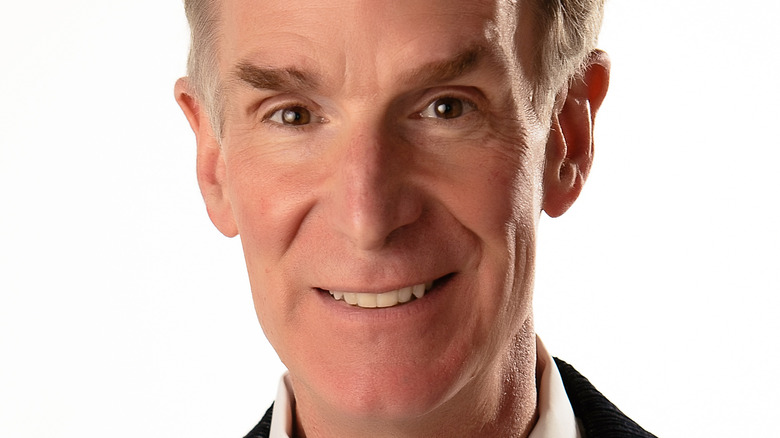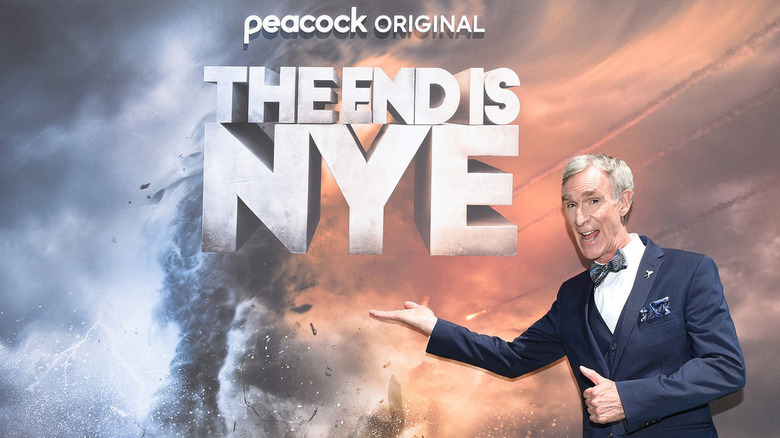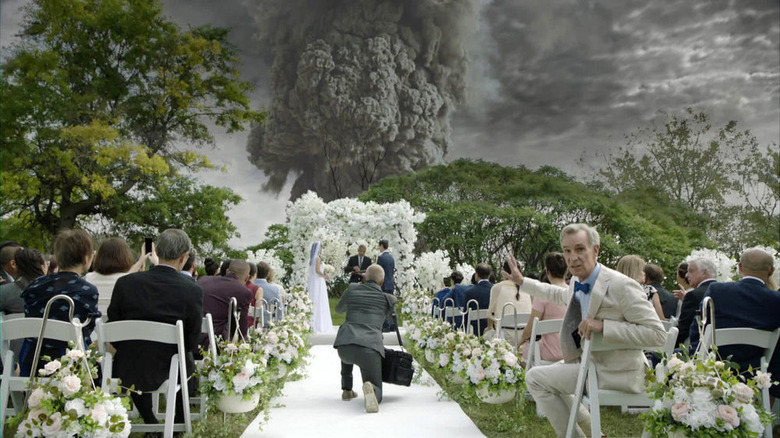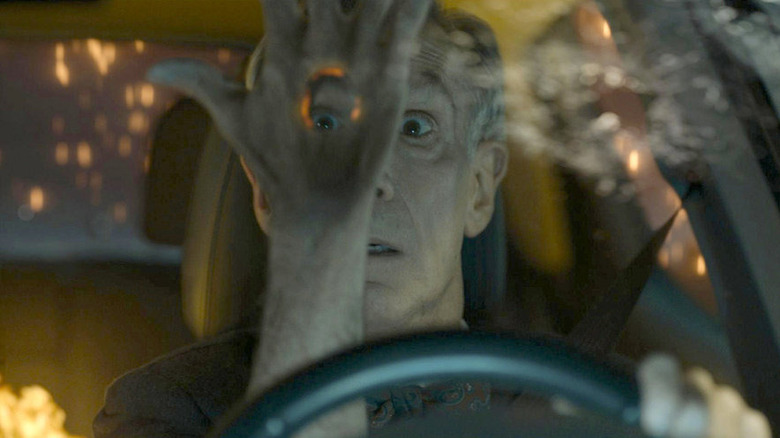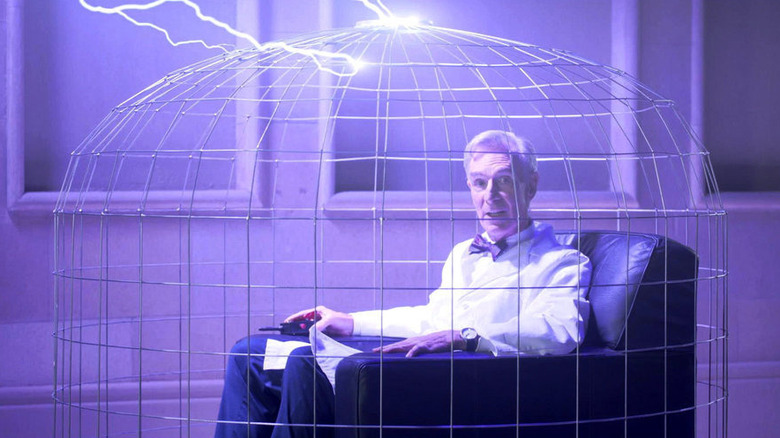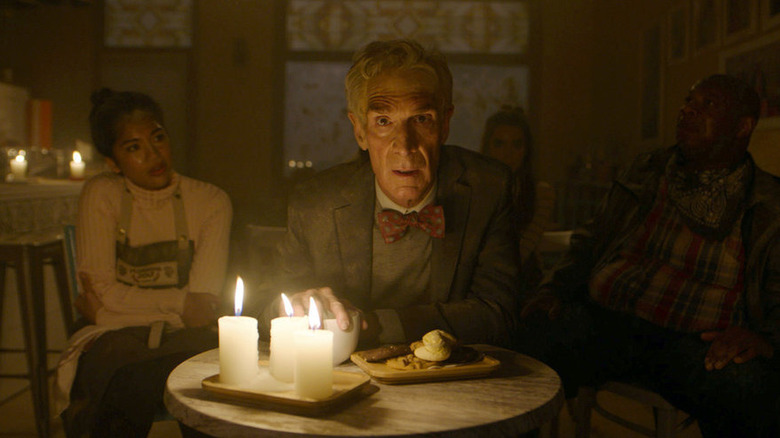Bill Nye Issues An Important Warning In His New Series The End Is Nye - Exclusive Interview
When exactly the world will end has been prophesied again and again for centuries. Now, between a global pandemic and global warming, the final day seems as though it's closer than ever before. In the new Peacock series "The End is Nye," Bill Nye the Science Guy is hoping those watching will heed his warning on what could possibly lead everyone on Earth to extinction.
Along with actor Seth MacFarlane, Nye will showcase six natural disasters throughout the series that could have far-reaching effects on mankind — ones that would destroy every ounce of life in its path. The goal isn't to cause worldwide panic, but instead to educate us on how humans are in control of writing an entirely new ending for planet Earth.
In an exclusive interview with The List, Nye told us why he wants his new series to "scare" anyone watching, shared his proudest achievement so far, and opened up about the feature film he hopes to make next.
Here's how The End is Nye all started
What was it that initially inspired you to create your series "The End is Nye" about the end of the world?
A surprising feature of human nature is when things in the world are going well, we all go to watch romantic comedies and comedy movies. When things are not — when things are anxiety-producing — then apparently we go watch disaster films.
There's a lot of anxiety in the world right now, so we made six one-hour disaster movies with a twist. The disaster happens in the first half hour, but then what we do about it and how we would make the world better for everybody is the second half hour. It's a new dual structure.
And more of an optimistic take on it.
It's all optimism with science.
What was it like working with Seth MacFarlane, who is known for comedy, on such dark subject matter?
Seth is the guy who said conservative media are successful. Everybody watches conservative media because they scare people. We got to scare people. That was Seth MacFarlane's vision, so we're scaring people in the first half hour.
But Seth is very concerned about science literacy, people being aware of scientific phenomena, and how we can use science to create technologies like this virtual meeting to make the world better.
This is the apocalyptic event Bill Nye admits he is most afraid of
Out of the six episodes, is there a disaster that you're most concerned about happening?
Well, I'm not joking that they're all grim, just some disclosure. At the end of the first half hour in each of the six episodes, I get killed ... Somehow I come back, and there we are.
The one that really has me thinking is the coronal mass ejection. This is a solar flare. The corona is the outer layer of a star like the sun, and it can have some of its mass, some of these charged particles, go shooting out with this big magnetic field and come toward the Earth. Then these charged particles — the energy in the charged particles — would interact with the Earth's magnetic field and turn off all the lights. All the electricity in the world would shut down.
We had a big one of these events — you probably don't remember — in 1859: the Carrington Event. There was a guy named Carrington [who] noticed the solar flare corresponded with these fires and these sparks and zapping incidents with telegraph wires and telegraph offices from this energy from the sun, and the Earth's magnetic fields caused fires.
[In] 1859, we had hardly any electrical infrastructure, some telegraph lines running here and there. Now, there are so many wires running everywhere all the time. If we had a couple of these mass ejections back to back, like the Earth spun 12 hours and it happened again, all the electricity in the world [would] shut off. No more refrigeration, no more cars, no more virtual movie interviews. It would be a drag really fast.
One of the big topics that you've discussed over the last few years is climate change. Is that what is going to be seen throughout the whole series?
The first episode is about this scenario, which apparently is mathematically possible. People at Goddard Institute for Space Studies and Penn State have done these computer models of the Earth's atmosphere and ocean, and you could have five enormous storms at the same time.
And the Earth — we don't have enough resources to handle that, all the displaced people, all the loss of clean water, and so on. That would be a disaster related to climate change. The corona mass ejection or the comet impact aren't climate change. But pumping down the aquifer — the Ogallala Aquifer out west — and making it so you can't irrigate crops, that would be a human-caused natural disaster.
We've got to avoid that, people. Watch the show. Turn it up loud!
The challenge of filming a series about the end of the world
Throughout the series, you really get into the thick of it. You're down in the mud, and you're being almost blown away in a scene. Was there something that was the most challenging to work on while making "The End is Nye"?
Running around in the rain is kind of fun. We had these huge fans, and if you let go of that light post, it would knock you right over. I got blown over onto some wrestling mats, but that was no big deal.
The only thing that went wrong is in the open. I'm running across the stage, and I've been wearing these dress shoes all day, and I didn't stretch. I pulled a muscle in my leg. Oh, the humanity. Did I get my head blown off in Ukraine? No, but I pulled a muscle, and I had to wrap it very tightly to walk around for a couple weeks. Wah, wah, wah.
But no — bring those things on. You want me to jump off the building? Let's go.
Bill Nye shares the best part about his job
I've been watching you on TV since I was a kid. Looking back at the course of your career, what's been your proudest achievement so far?
Well, it's when people like you say you used to watch the show, and now you have a job. You're a productive member of society. That's pretty cool. It's amazing to me. We did the show in a warehouse in Seattle, the 13th television market. It's a backwater, but we put our hearts and souls into it, and the people I worked with were funny. They had excellent senses of humor. When you all are watching the show 30 years later and still talking about the show, that is amazing. That's pretty cool.
You've said in past interviews that your goal is to change the world and to inspire generations that are watching. What's been your most memorable or meaningful fan encounter that you've had?
There have been many, but it's when people say, "I became a doctor." When I was in science, when I went to engineering school, there were very few women — and very few is an understatement. Hardly any women in engineering. Now there are many.
Where I went to school, Cornell University, I was there for my 45th reunion ... These students are taking this forklift apart. With mechanical engineers, a forklift is the greatest thing. It's got motors and belts and chains and the weight balance and the steering in the back. It's fabulous ... Racks and pinions, and oh, my goodness. Anyway, they were taking this thing apart, grease up to their elbows, and they were three women — three young women students. That never used to be the case when I was in school. When those people say they went into engineering because they watched the show, that's very cool to me.
The hope — our goal here — is to get people to watch the show, appreciate the disasters that could happen to humankind, and do something about it because they watch the show or do something about them. That's our objective now.
He wants to make a movie next
You're an author, you've been on television, and you have a podcast, among many other things. What have you not done yet that you would like to achieve still?
There's a movie I want to make — a real theatrical release movie. As you may know, I lived for a long time in Los Angeles, and somebody comes to the door every year in uniform, and you have to show them your screenplay. You have to have a screenplay, or they give you a ticket. That's a joke, everybody! [Laughs] But where I live, everybody has a screenplay.
I have a screenplay about Nathaniel Bowditch, who was born in Massachusetts before the U.S. was the U.S. He found a new way to compute your longitude without a clock, using the moon. And he translated these famous books, "Celestial Mechanics," into English, because he taught himself French. If you go to the Library of Congress, in the hall of astronomy and mathematics, his name's on the ceiling. It's a cool story, and I want to make a movie about it, since you asked.
I don't know the details of that story. I'd love to see it.
Well, that's why we got to make this movie.
All six episodes of "The End is Nye" will be available to stream Thursday, August 25 exclusively on Peacock.
This interview was edited for clarity.
